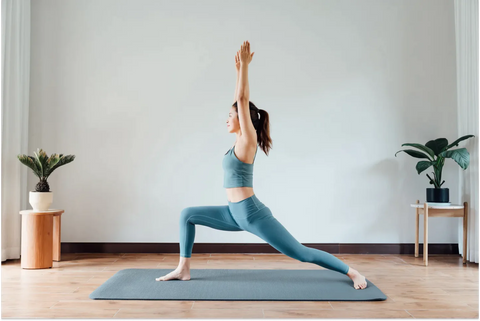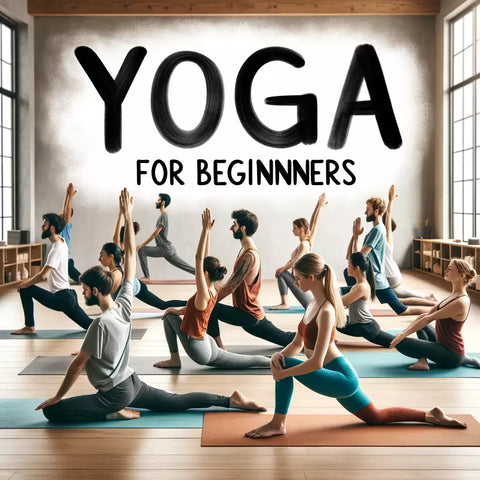Yoga Tips for Beginners: Embarking on Your Yoga Journey
Embarking on a yoga journey can be a transformative experience. ItYoga offers many mental and physical benefits to people of all ages. For beginners, understanding the basics of yoga is crucial to a successful and fulfilling practice.
Yoga has a rich philosophy that goes beyond physical postures. Understanding concepts like mindfulness, balance, and unity with oneself is fundamental.
If you want to have a deeper understanding of the charm of yoga, matching yoga clothing is indispensable. You can refer to IUGA's yoga clothing to choose the yoga clothing that best suits you. This article is a comprehensive guide for those entering the world of yoga. It provides insights, tips and practical advice.
The Basics of Yoga

Yoga is a vast and ancient practice encompassing more than physical postures (asanas). It's a holistic approach to integrating mind, body, and spirit, ultimately leading to harmony and well-being. At the same time, there are many paths within yoga.
Yoga's foundation is ancient Indian philosophy, emphasizing ethical principles (Yamas and Niyamas) for mindful living. The Eight Limbs roadmap outlines eight interconnected practices leading to liberation and self-realization. Asanas (physical postures) are just one limb, though they are often the most well-known in the West.
These physical exercises improve flexibility, strength, balance, and posture. Common beginner postures include Mountain Pose (Tadasana), Downward-Facing Dog (Adho Mukha Svanasana), and Child's Pose (Balasana).
Controlled breathing exercises like Ujjayi Pranayama calm the mind and reduce stress. Yoga incorporates meditation techniques to cultivate focus, presence, and inner peace. Explore styles like Hatha, Vinyasa, or Yin to find one that suits your preferences.
Creating a Conducive Yoga Environment

Creating a conducive environment can enhance your practice, whether you're a seasoned yogi or starting one.
1. Cleanliness and Order
Ensure your space is tidy and clutter-free. Promote a sense of calmness.
2. Light
Use natural light if possible. If not, use soft, warm lighting to create a relaxing atmosphere. Avoid harsh overhead lights.
3. Decorations
Surround yourself with soothing visuals that inspire you. Use natural like nature photographs, calming artwork, or inspirational quotes.
4. Sound
Play calming music with slow tempos and gentle melodies. Or, practice in silence for a more meditative experience.
5. Aromatherapy
Use oils like lavender, sandalwood, or chamomile to create a relaxing aroma. Ensure proper ventilation and dilute oils as needed.
6. Temperature
Adjust the temperature to your comfort level. Avoid practicing in extremes.
7. Yoga Mat
Invest in a comfortable, supportive yoga mat with adequate cushioning and grip.
8. Props
Have yoga blocks, straps, and bolsters available for modifications and deeper stretches.
9. Clothing
Opt for clothing that is loose and comfortable, enabling unrestricted movement.
10. Incorporate Plants
Surround yourself with greenery. Plants can improve air quality and promote relaxation.
Basic Yoga Poses for Beginners
Here are three basic yoga poses that are great for beginners:
1. Mountain Pose/Tadasana
Stand with your feet together or hip-width apart, distributing your weight evenly on both feet. Engage your thigh muscles and lift your chest. Roll your shoulders back and down, away from your ears. Extend your arms alongside your body, palms facing forward, or bring them together in prayer.
2. Downward-Facing Dog /Adho Mukha Svanasana
Start on your hands and knees, with wrists under shoulders and knees under hips. Tuck your toes and lift your hips towards the ceiling, straightening your legs. Spread your fingers wide and press your palms into the mat. Keep your head between your arms, relaxing your neck. Aim to create an inverted V shape with your body.
3. Child's Pose /Balasana
Kneel on the mat with your big toes touching and knees hip-width apart. Sit back on your heels and extend your arms forward, lowering your chest toward the mat. Rest your forehead on the mat and relax your neck. Take slow, deep breaths, allowing your spine to lengthen and your hips to sink towards your heels.
Stand with your feet together or hip-width apart, distributing your weight evenly on both feet. Engage your thigh muscles and lift your chest. Roll your shoulders back and down, away from your ears. Extend your arms alongside your body, palms facing forward, or bring them together in prayer.
Importance of Breathing in Yoga
Breathing is a fundamental aspect of yoga. Here are some key reasons highlighting the importance of breathing in yoga:
1. Mind-Body Connection
Yoga places a strong emphasis on the mind-body connection. Controlled breathing, known as pranayama, serves as a bridge between the two. By focusing on the breath, practitioners cultivate awareness of their body, thoughts, and emotions.
2. Stress Reduction
Deep, mindful breathing activates the parasympathetic nervous system, promoting relaxation and reducing the effects of stress. Incorporating conscious breathing into yoga helps calm the mind and reduce anxiety.
3. Enhances Concentration
Coordinating movement with breath in yoga postures requires concentration. This focused attention helps to quiet the mind and improve concentration. It also helps to prevent distractions and foster a sense of presence.
4. Optimizes Oxygen Intake
Proper breathing ensures an optimal intake of oxygen, promoting better circulation. This oxygenates the blood and muscles, enhancing physical performance during yoga asanas.
5. Energetic Flow
According to yogic philosophy, prana is the life force or vital energy. Through specific breathing techniques, practitioners aim to balance and enhance the flow of prana within the body. This can contribute to increased vitality and a sense of well-being.
6. Detoxification
Deep, diaphragmatic breathing facilitates the removal of toxins from the body, promoting better circulation and encouraging the lymphatic system's function. This detoxifying effect can contribute to improved overall health.
Developing a Regular Yoga Routine

Building a regular yoga routine requires dedication and flexibility.
Begin with 10-15 minutes: Don't overwhelm yourself. Aim for consistency over duration initially.
Practice 2-3 times a week: Gradually increase frequency as you become comfortable.
Choose convenient times. Fit practice into your schedule, whether it's mornings, evenings, or during lunch breaks.
Listening to Your Body
Our bodies are wise messengers, constantly communicating our needs and wants. Often, in the hustle and bustle of life, we miss these subtle cues, leading to imbalances and disharmony. Cultivating the art of listening to your body can be transformative, bringing greater awareness, well-being, and fulfillment to your life. Here are some key aspects of listening to your body.
Pay attention to aches, pains, and discomfort. They may indicate injuries, stress, or muscle tension. Feeling drained or sluggish could indicate the need for rest, better sleep, or healthier eating habits. Observe your breath. Is it shallow or rapid? Tightness in your chest could indicate anxiety or overwhelm.
Are you frequently agitated, sad, or anxious?
Ignoring emotions can manifest in physical symptoms. Gut feelings often arise from subconscious wisdom. Pay attention to unexplainable urges or discomfort with certain situations. Do certain interactions leave you drained or energized? Recognizing triggers can help you make choices that align with your well-being.
Exploring Different Yoga Styles
Here's a brief overview of some popular yoga styles.
1. Hatha Yoga
Known for its slower pace, Hatha yoga focuses on basic postures and breath control. It's great for beginners and those seeking a gentle introduction to yoga.
2. Vinyasa Yoga
This style emphasizes the flow of movement synchronized with the breath. Vinyasa classes often involve a series of poses that smoothly transition from one to another, promoting flexibility and strength.
3. Ashtanga Yoga
Ashtanga is a more rigorous and structured style that involves a specific sequence of poses followed by practitioners. It's physically demanding and helps build strength, flexibility, and stamina.
4. Iyengar Yoga
The practice of Iyengar yoga focuses on Iyengar yoga. Props such as blocks and straps often help students achieve the proper form in each pose.
5. Bikram Yoga (Hot Yoga)
Bikram yoga consists of 26 poses practiced in a heated room. The heat is believed to enhance flexibility and detoxification. Each class follows the same sequence of poses.
6. Kundalini Yoga
Kundalini focuses on awakening spiritual energy through breathwork, meditation, and dynamic movements. Classes may involve chanting and specific sequences known as kriyas.
7. Yin Yoga
Yin yoga targets the connective tissues, holding passive stretches for an extended period. It's a slow-paced practice that enhances flexibility and cultivates a meditative mindset.
8. Restorative Yoga
Restorative yoga is about relaxation and rejuvenation. Poses are held for longer periods with the support of props, allowing the body to release tension and promote deep relaxation.
9. Power Yoga
Power yoga is a dynamic and vigorous style inspired by Ashtanga. It focuses on building strength, flexibility, and endurance through a challenging sequence of poses.
10. Anusara Yoga
Anusara combines a strong emphasis on alignment with a heart-centered approach. Classes often include a mix of poses, breathwork, and philosophy.
11. Jivamukti Yoga
Jivamukti integrates physical postures with spiritual teachings, music, and meditation. It's a holistic practice that emphasizes ethical and environmental consciousness.
12. AcroYoga
AcroYoga blends yoga, acrobatics, and Thai massage. It involves partner and group poses and fosters trust, communication, and playfulness.
13. Aerial Yoga
Aerial yoga incorporates silk hammocks suspended from the ceiling to support and deepen traditional yoga poses. It enhances flexibility and core strength.
14. Sivananda Yoga
Sivananda follows a set sequence of poses, including relaxation and breathing exercises. It emphasizes a balanced lifestyle, combining physical postures with spiritual teachings.
Yoga Tips for Beginners

● Meditation, deep breathing, and body scans can enhance your awareness of internal cues.
● Exercise helps release tension, improve circulation, and boost energy levels.
● Adequate sleep is vital for physical and mental recovery.
● Eating well provides the fuel your body needs to function optimally.
● Spending time outdoors can be calming and grounding, fostering a deeper connection to your body and its rhythms.
● If chronic pain, overwhelming emotions, or confusion persist, consult a therapist.
Conclusion
As a beginner, embarking on a yoga journey is a transformative experience beyond physical exercise. It's a journey of self-discovery, holistic well-being, and personal growth.
By integrating the outlined techniques into practice, beginners can lay a solid foundation for a fulfilling and sustainable yoga journey. When we reach a certain foundation, we can also try 10 chair yoga poses to experience a different charm of yoga.
FAQs
1. What is yoga exercise?
Yoga exercises involve a combination of physical postures, breath control, and meditation. The practice aims to enhance flexibility, strength, and balance. At the same time, they are promoting mental well-being and relaxation. It is a holistic approach that integrates body, mind, and spirit for overall health.
2. How to do yoga for beginners?
Starting yoga is an exciting journey. Find a comfy, quiet spot with space to move. Wear comfy clothes and use a yoga mat. Try easy poses like Mountain, Downward-Facing Dog, and Child's Pose. Breathe deeply through your nose. Use online videos for beginners.
Add harder poses as you get comfy, but be gentle and listen to your body. End each session with relaxing moments. Do yoga regularly, even a few minutes a day. Try styles like Hatha, Vinyasa, or Yin to see what you like. Remember, go at your own pace. If unsure, ask a doctor before starting. Enjoy your yoga adventure.
3. What are the benefits of yoga?
Benefits of practicing yoga poses (asanas) regularly can help improve flexibility.Deep breathing, meditation, and mindful movement can help reduce stress levels.
Yoga encourages awareness of body alignment, leading to improved posture and reduced strain on the spine and muscles.
Yoga emphasizes the connection between breath and movement.
Regular practice can boost energy levels.
The stress-reducing and balancing effects of yoga may contribute to a strengthened immune system.
Yoga has been associated with reduced pain levels.
Regular yoga practice has been linked to improved sleep quality and sleep disorders.












